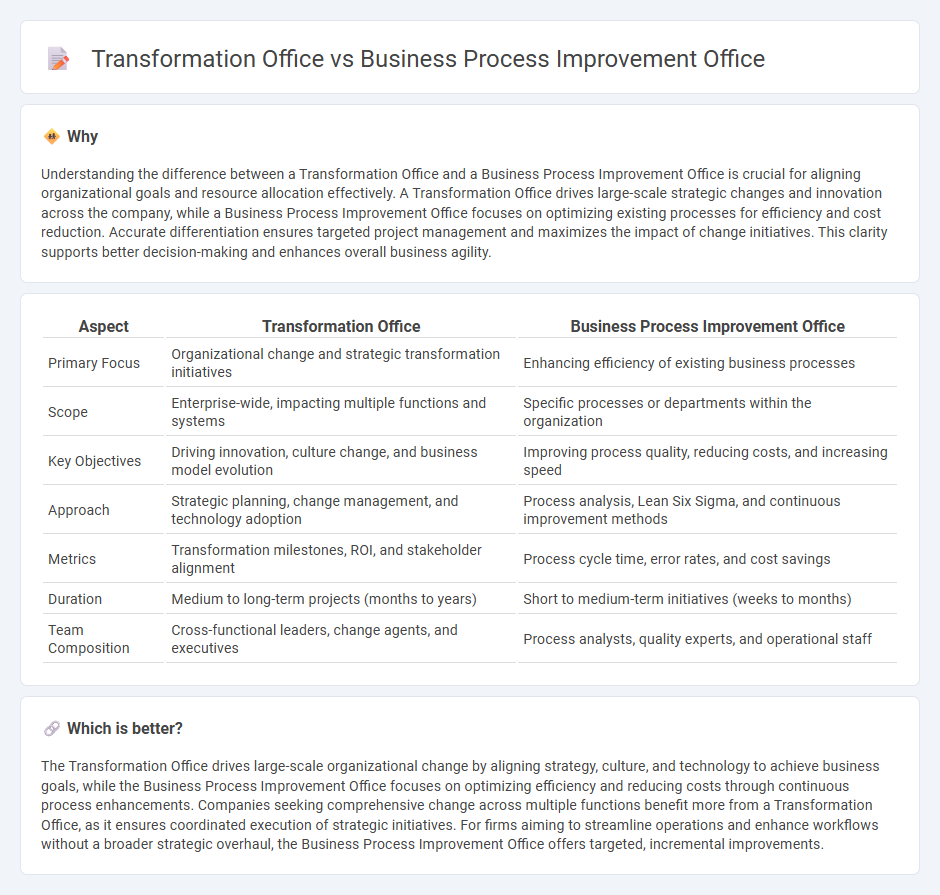
A Transformation Office drives strategic change across the organization by managing large-scale initiatives that align with long-term business goals, while a Business Process Improvement Office focuses on optimizing and streamlining operational workflows to enhance efficiency and reduce costs. Both offices play critical roles in organizational growth yet differ in scope and execution, with the Transformation Office orchestrating overarching change and the Improvement Office honing continuous process enhancements. Explore how each office can uniquely accelerate your company's success and operational excellence.
Why it is important
Understanding the difference between a Transformation Office and a Business Process Improvement Office is crucial for aligning organizational goals and resource allocation effectively. A Transformation Office drives large-scale strategic changes and innovation across the company, while a Business Process Improvement Office focuses on optimizing existing processes for efficiency and cost reduction. Accurate differentiation ensures targeted project management and maximizes the impact of change initiatives. This clarity supports better decision-making and enhances overall business agility.
Comparison Table
| Aspect | Transformation Office | Business Process Improvement Office |
|---|---|---|
| Primary Focus | Organizational change and strategic transformation initiatives | Enhancing efficiency of existing business processes |
| Scope | Enterprise-wide, impacting multiple functions and systems | Specific processes or departments within the organization |
| Key Objectives | Driving innovation, culture change, and business model evolution | Improving process quality, reducing costs, and increasing speed |
| Approach | Strategic planning, change management, and technology adoption | Process analysis, Lean Six Sigma, and continuous improvement methods |
| Metrics | Transformation milestones, ROI, and stakeholder alignment | Process cycle time, error rates, and cost savings |
| Duration | Medium to long-term projects (months to years) | Short to medium-term initiatives (weeks to months) |
| Team Composition | Cross-functional leaders, change agents, and executives | Process analysts, quality experts, and operational staff |
Which is better?
The Transformation Office drives large-scale organizational change by aligning strategy, culture, and technology to achieve business goals, while the Business Process Improvement Office focuses on optimizing efficiency and reducing costs through continuous process enhancements. Companies seeking comprehensive change across multiple functions benefit more from a Transformation Office, as it ensures coordinated execution of strategic initiatives. For firms aiming to streamline operations and enhance workflows without a broader strategic overhaul, the Business Process Improvement Office offers targeted, incremental improvements.
Connection
The transformation office drives strategic change initiatives, aligning them with long-term business goals, while the Business Process Improvement Office focuses on optimizing operational workflows and increasing efficiency. Both offices collaborate to ensure that process improvements support the broader transformation agenda, enabling seamless adoption of new strategies and technologies. This connection fosters consistent performance metrics, accelerates innovation, and ensures sustainable organizational growth.
Key Terms
Continuous Improvement
The Business Process Improvement Office centers on continuous refinement of existing workflows to enhance efficiency, reduce costs, and improve customer satisfaction through incremental changes. The Transformation Office drives large-scale organizational change, integrating new technologies and business models to achieve strategic goals beyond routine improvements. Explore how aligning these offices can accelerate sustainable growth and innovation in your enterprise.
Change Management
The Business Process Improvement Office specializes in optimizing workflows and enhancing operational efficiency through methodologies like Lean and Six Sigma, emphasizing incremental change. The Transformation Office oversees broader organizational change, integrating strategic initiatives that align with long-term corporate goals, often managing cultural, technological, and structural shifts. Explore detailed strategies and frameworks to understand how change management varies between these two critical functions.
Strategic Alignment
The Business Process Improvement Office centers on optimizing existing workflows to enhance efficiency and reduce costs, ensuring processes align with organizational goals. In contrast, the Transformation Office drives large-scale strategic initiatives that redefine business models and foster innovation for long-term growth. Explore more to understand how each office supports strategic alignment in evolving business landscapes.
Source and External Links
Business Process Improvement Office - AITS - The Business Process Improvement Office at University of Illinois coordinates and facilitates process improvement engagements using methods like Kaizen events and process mapping, providing leadership, training, and tools to help units improve processes across functions since 2011.
Business Process Improvement: Guide and Case Study - HEFLO - Business Process Improvement (BPI) is a structured approach to analyze, optimize, and redesign business workflows to eliminate waste, automate tasks, reduce costs, and align processes with strategic goals for sustainable growth and efficiency.
Business Process Improvement - The U.S. Army's BPI program uses methodologies like Lean Six Sigma and Business Process Reengineering to improve accuracy, effectiveness, and efficiency of processes, with involvement from financial management to validate cost savings and support cross-domain improvements.
 dowidth.com
dowidth.com